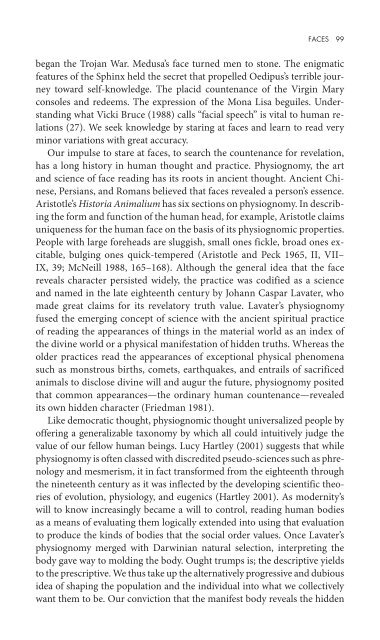Staring how we look sobre la mirada.pdf - artecolonial
Staring how we look sobre la mirada.pdf - artecolonial
Staring how we look sobre la mirada.pdf - artecolonial
You also want an ePaper? Increase the reach of your titles
YUMPU automatically turns print PDFs into web optimized ePapers that Google loves.
A SOCIAL RELATIONSHIP 45<br />
conditions such as alcoholism, homosexuality, mental disability, criminality,<br />
and unemployment. Finally are what he calls the “tribal affiliations” of race,<br />
ethnicity, nationality, and religion. The people remaining without supposed<br />
besmirchments are the “normals” (5). Everyone with potentially discreditable<br />
traits must navigate a <strong>we</strong>b of shifting social expectations and sources of status.<br />
Stigma, in short, is prejudicial judgment against appearing different from the<br />
“normals.”<br />
When the social sorting process of stigmatization shaves off everyone<br />
from the mildly discredited to the “abominations,” the lingering untainted<br />
“normals” are an elite minority. Goffman (1986) sums up this archetypal<br />
“normal” as the “only one complete unblushing male in America: a young,<br />
married, white, urban, northern, heterosexual, Protestant father of college<br />
education, fully employed, of good complexion, <strong>we</strong>ight and height, and a<br />
recent record in sports” (128). The ironic point in this description is that<br />
the prototypical figure of normalcy is not what <strong>we</strong> actually see everywhere<br />
but rather is what <strong>we</strong> expect to see. The illusion of the normal is often what<br />
people reach for in creating self-presentations, particu<strong>la</strong>rly those in the public<br />
eye such as politicians, executives, or news anchors, for example. This<br />
phantom figure of the “normate” is “the veiled subject position of the cultural<br />
self, the figure outlined by the array of deviant others whose marked bodies<br />
shore up the normate’s boundaries” (Gar<strong>la</strong>nd Thomson 1996, 8). 19 Actual<br />
normates are as scarce as hen’s teeth, whereas imagined normates preside<br />
over the public <strong>la</strong>ndscape. So while the “abominations” that life makes of<br />
so many of us are always among us, their presence is a perpetual surprise.<br />
We become inured to our own “abominations” for the most part, so when<br />
the uncivil attention of the stigmatizing process comes our way, it seems an<br />
indignity, as <strong>we</strong> saw with Fanon’s experience of racism.<br />
Stigmatizing is a social process that hurdles a body from the safe shadows<br />
of ordinariness into the bull’s-eye of judgment. As appearance became<br />
standardized in the modern world, particu<strong>la</strong>rity came to be understood as<br />
aberration rather than simple variation or distinctiveness. The seen body<br />
is our primary mode of perceiving and understanding scale, symmetry,<br />
ba<strong>la</strong>nce, which are the coordinates of ordinariness. Comparisons to what<br />
<strong>we</strong> expect determine our understanding of “abominations,” of the disproportionate,<br />
grotesque, deformed, miniature, gigantic, or unusual (Stewart<br />
1984). A proto-ordinary body becomes an authentic body, the one <strong>we</strong> think<br />
of as normal or call able-bodied.<br />
The stigmatizing process is uncomfortable for everybody involved. Stigma<br />
comes to people not only from vio<strong>la</strong>ting ordinariness but also from disrupting<br />
the effortless mutual granting of civil inattention that gets us through<br />
our day. Social co-presence requires that <strong>we</strong> do not spark one another’s fears,<br />
anxiety, embarrassment, or disgust. “The stigmatized,” as William Ian Miller


